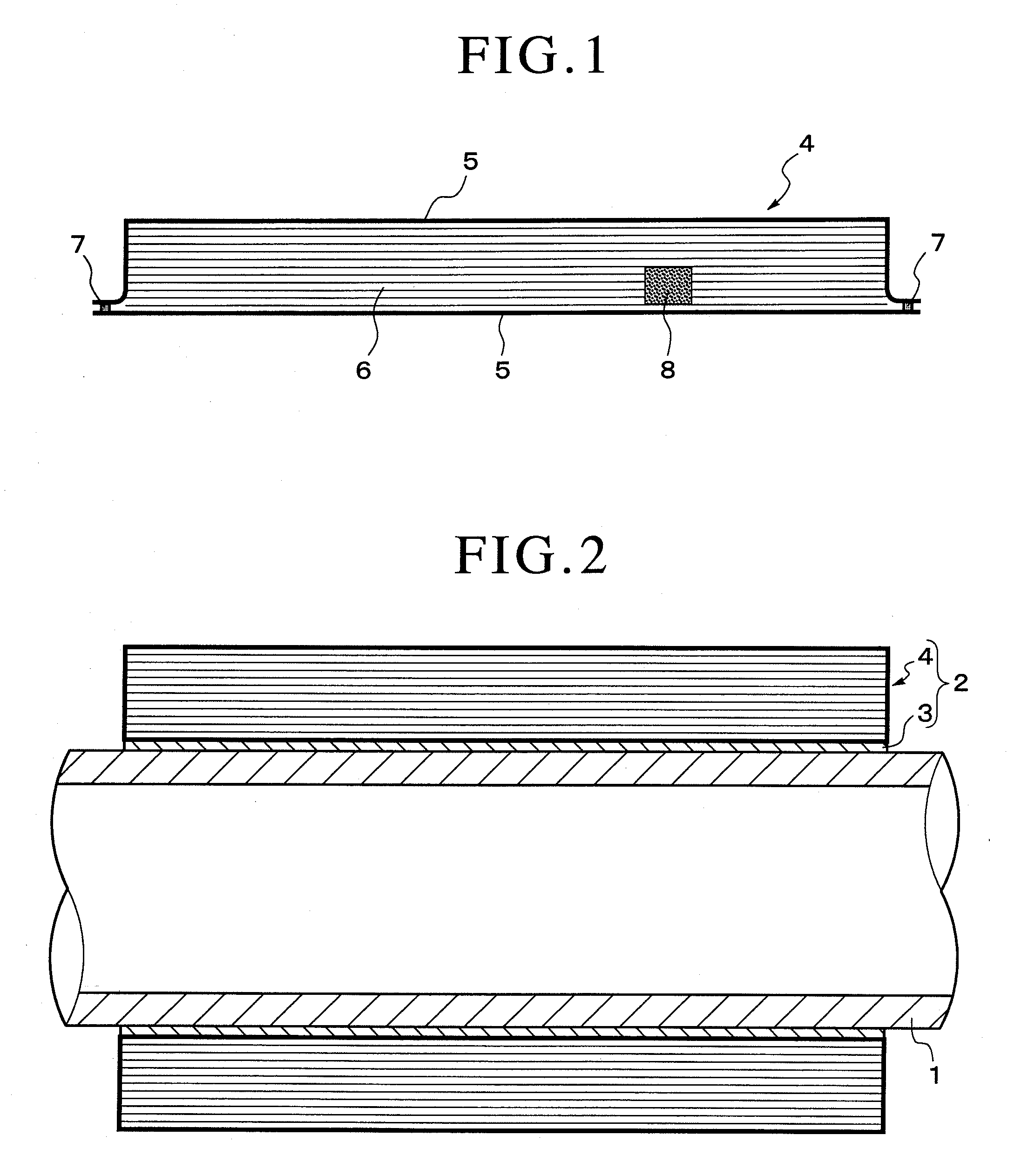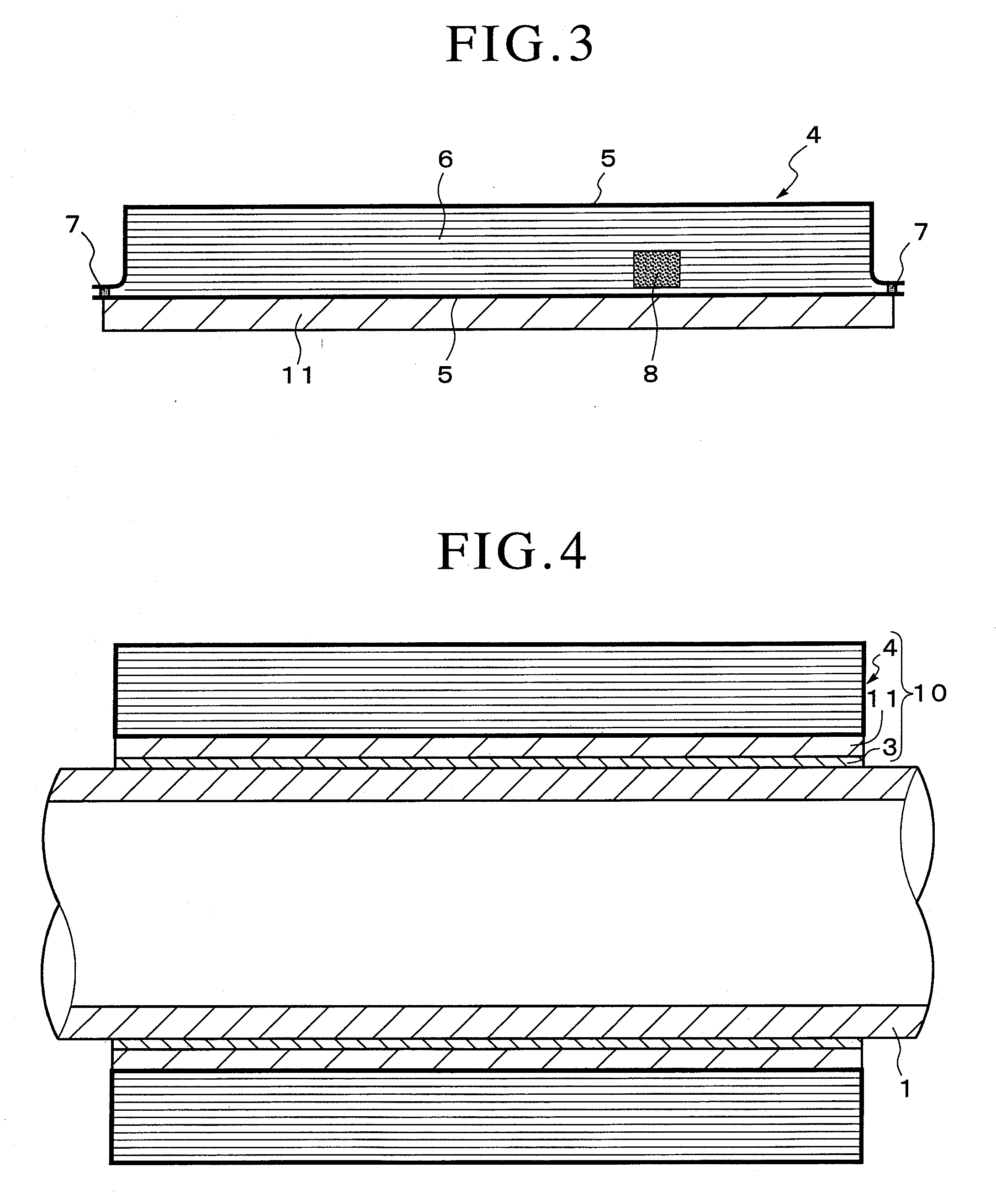Heat resisting vacuum insulating material and heating device
a vacuum insulating material and heat-resisting technology, which is applied in the direction of heater elements, machines/engines, light and heating apparatus, etc., can solve the problems of large energy efficiency problems, piping resistance to exhaust gas becomes too great to continue vacuumizing, and the yield of dust to the semiconductor circuit substrate brings a drop in yield, so as to prevent the yield from being reduced, reduce the workload of hazardous maintenance work, and reduce the effect of sticking
- Summary
- Abstract
- Description
- Claims
- Application Information
AI Technical Summary
Benefits of technology
Problems solved by technology
Method used
Image
Examples
first embodiment
[0048]FIG. 1 and FIG. 2 show the heating device in a first embodiment, in which the heating device 2 is substantially composed of an electric heater 3 arranged along the outer wall of the exhaust pipe 1 and a heat resisting vacuum insulator 4 covering the outer periphery of the electric heater 3.
[0049]The electric heater 3 further comprises a resistance heating element and a heat resisting electric insulator made up of an organic macromolecular material and covering the resistance heating element.
[0050]The resistance heating element is a wire-shaped or sheet-shaped item made of a metallic or carbon-based material having a high electric resistance, which preferably may be 0.5 to 100Ω. Where a wire-shaped item is used as the resistance heating element, it is preferable that its thickness be between 50 and 1000 μm, and where a sheet-shaped item is used, it is preferable that its thickness be between 10 μm and 100 μm.
[0051]More specifically, suitable carbon-based resistance heating elem...
second embodiment
[0059]FIG. 3 through FIG. 5 show a second embodiment of the invention and a modified version of the same. The same constituent parts as those in FIG. 1 and FIG. 2 are assigned respectively the same reference signs, and their description is simplified.
[0060]As shown in FIG. 3 and FIG. 4, the heating device 10 has an insulating material 11, made up of an inorganic material, disposed between the heating device 2 and the exhaust pipe 1 in the first embodiment, while a heating device 20 shown in FIG. 5 has an insulating material 21, made up of an organic or inorganic material, wound around the outer periphery of the heating device 10 of FIGS. 3 and 4.
[0061]Inorganic materials usable for the insulating materials 11 and 21 include cloth knit of non-boron glass, such as soda glass, fibers or quartz fibers and calcium silicate boards. The reason why boron-containing glass fibers, such as borosilicate glass processed into fibers, are not used is to avoid the problem of diffusion of boron comp...
example 1
[0066]To assess the heating performances of the heating devices according to the invention and the insulating performances of the heat resisting vacuum insulators used therein, the following performance tests were carried out.
(1) Heat Resisting Vacuum Insulators
[0067]The heat resisting vacuum insulators were prepared in the following way.
[0068]For the metal sheet to constitute the covering for keeping the vacuum within each heat resisting vacuum insulator, a metallic foil basically having no gas transmissivity, such as an aluminum foil or a stainless steel foil was used. When an aluminum foil was used in particular, a plastic protective sheet was stuck to the atmosphere-facing surface of this foil to prevent it from being broken. On the vacuum side, it had an adhesive layer made up of an adhesive resin to apply sealing to maintain the vacuum.
[0069]For the filling material to be contained in the metal sheet, a molded item formed by heat-resistant fibrous, ball-shaped or otherwise sha...
PUM
 Login to View More
Login to View More Abstract
Description
Claims
Application Information
 Login to View More
Login to View More - R&D
- Intellectual Property
- Life Sciences
- Materials
- Tech Scout
- Unparalleled Data Quality
- Higher Quality Content
- 60% Fewer Hallucinations
Browse by: Latest US Patents, China's latest patents, Technical Efficacy Thesaurus, Application Domain, Technology Topic, Popular Technical Reports.
© 2025 PatSnap. All rights reserved.Legal|Privacy policy|Modern Slavery Act Transparency Statement|Sitemap|About US| Contact US: help@patsnap.com



